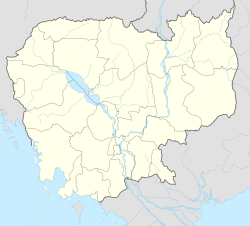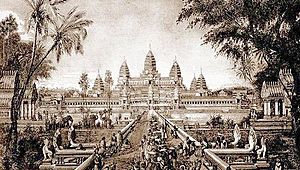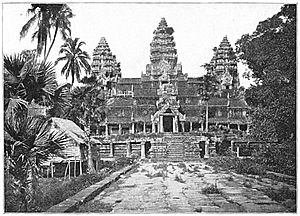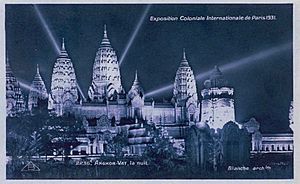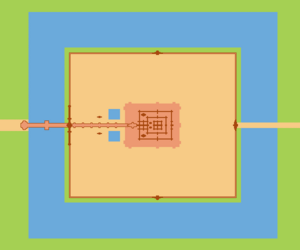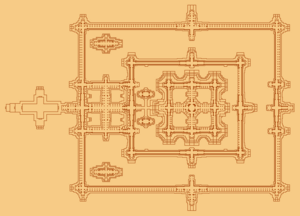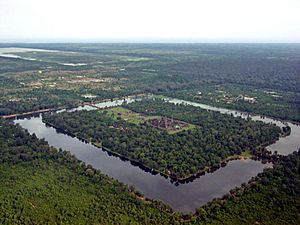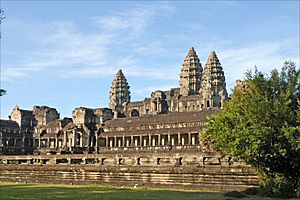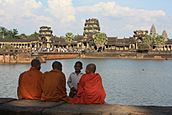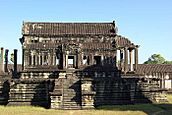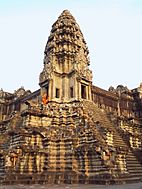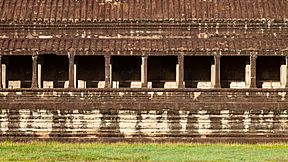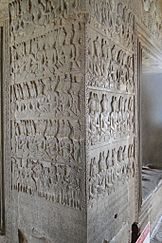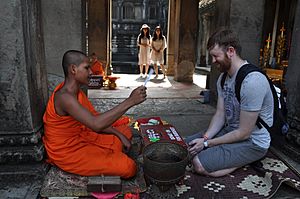Angkor Wat facts for kids
|
អង្គរវត្ត
|
|
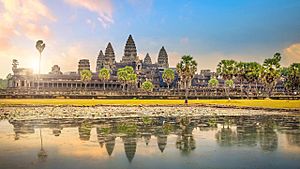
Front side of the main complex
|
|
| Location | Siem Reap, Cambodia |
|---|---|
| Coordinates | 13°24′45″N 103°52′0″E / 13.41250°N 103.86667°E |
| Altitude | 65 m (213 ft) |
| History | |
| Builder | Started by Suryavarman II Completed by Jayavarman VII |
| Founded | 12th century |
| Cultures | Khmer Empire |
| Architecture | |
| Architectural styles | Khmer (Angkor Wat style) |
| Official name: Angkor | |
| Type: | Cultural |
| Criteria: | i, ii, iii, iv |
| Designated: | 1992 (16th session) |
| Reference #: | 668 |
| Region: | Asia and the Pacific |
Angkor Wat (Khmer: អង្គរវត្ត, meaning "City of Temples") is a huge temple complex in Cambodia. It is the largest religious building in the world! In the early 1100s, the Khmer King Suryavarman II ordered it to be built in a place called Yaśodharapura (now known as Angkor). It was first a Hindu temple, built for the god Vishnu. But by the end of the 12th century, it had become a Buddhist temple. Today, people often call it a "Hindu-Buddhist" temple.
The temple's first name was Vrah Viṣṇuloka, which means "the sacred home of Vishnu." The name Angkor Wat means "Temple City" or "City of Temples" in the Khmer language.
Angkor Wat combines two main styles of Khmer temple building. It has a "temple-mountain" design and also uses "galleried" areas. The temple is built to look like Mount Meru. This mountain is believed to be the home of the gods in Hindu mythology. It has a moat (a water-filled ditch) over 5 kilometers (3 miles) long. Inside, there's an outer wall 3.6 kilometers (2.2 miles) long. There are also three rectangular galleries, each one higher than the last. In the very center, five towers stand together.
Most temples in Angkor face east, but Angkor Wat faces west. Experts are still discussing why this is. People admire the temple for its grand and balanced design. They also love its many detailed bas-reliefs (carvings on walls) and the beautiful devata figures that decorate it.
History of Angkor Wat
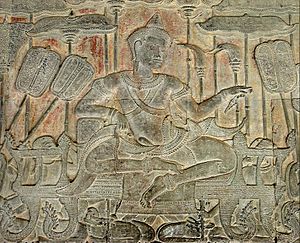
Angkor Wat is about 5.5 kilometers (3.4 miles) north of the modern town of Siem Reap. It is also a short distance south and east of the old capital city, which was centered at Baphuon. Angkor Wat is the most southern of the main ancient sites in the Angkor area of Cambodia.
Building the Temple
King Suryavarman II ruled from 1113 to about 1150 CE. The construction of Angkor Wat took about 28 years, from 1122 to 1150 CE. A wise religious leader named Divākarapaṇḍita encouraged the king to build the temple. All the first religious carvings and ideas at Angkor Wat came from Hinduism. Unlike earlier kings who worshiped the god Shiva, King Suryavarman II dedicated Angkor Wat to Vishnu. It was built to be the king's main temple and capital city.
We don't know the temple's first name for sure. No original stone tablets or writings about it have been found. But it might have been called "Varah Vishnu-lok" after the god Vishnu. Work on the temple seems to have stopped soon after the king died. This left some of the bas-relief carvings unfinished. The name Vrah Viṣṇuloka also means "The king who has gone to the supreme world of Vishnu." This name honors King Suryavarman II after his death.
Changes Over Time
About 27 years after King Suryavarman II died, in 1177, Angkor was attacked by the Chams. They were old enemies of the Khmer people. Later, a new king, Jayavarman VII, brought the empire back to power. He built a new capital (Angkor Thom) and a new state temple (Bayon) a few kilometers north. These new sites were dedicated to Buddhism. This was because the king felt the Hindu gods had not helped him. Because of this, Angkor Wat slowly became a Buddhist site. Many Hindu statues were replaced with Buddhist art.
By the end of the 12th century, Angkor Wat had mostly changed from a Hindu worship center to a Buddhist one. It remains Buddhist to this day. Angkor Wat is special among the Angkor temples. Even though it was mostly left alone after the 1500s, it was never completely empty. Writings from the 1600s show that Japanese Buddhist travelers had small communities there. They lived alongside local Khmer people. These Japanese visitors thought the temple was the famous Jetavana garden of the Buddha in India. One well-known writing tells of Ukondayu Kazufusa, who celebrated the Khmer New Year at Angkor Wat in 1632.
Western Visitors and Rediscovery
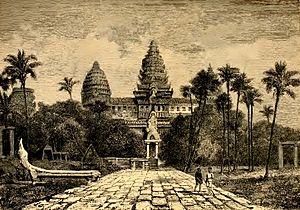
One of the first Westerners to see the temple was António da Madalena. He was a Portuguese friar who visited in 1586. He said it was "of such extraordinary construction that it is not possible to describe it with a pen." He added that "it is like no other building in the world."
In 1622, a poem called The Poem of Angkor Wat was written in Khmer. It describes the beauty of Angkor Wat. It also tells a legend that the temple was a divine castle. It was supposedly built for a legendary Khmer king by the Hindu god Preah Pisnukar. This shows that King Suryavarman II was already forgotten by the people.
In 1860, the French explorer Henri Mouhot helped make the site famous in the West. He published his travel notes, writing:
One of these temples, a rival to that of Solomon, and erected by some ancient Michelangelo, might take an honorable place beside our most beautiful buildings. It is grander than anything left to us by Greece or Rome.
There were no ordinary homes or signs of people living at Angkor Wat. There were no cooking tools, weapons, or clothes. Only the monuments themselves were found. This suggests it was a special, sacred place.
The amazing art of Angkor Wat and other Khmer buildings led France to take control of Cambodia. This happened on August 11, 1863. France also invaded Siam to gain control of the ruins. This helped Cambodia get back lands like Siem Reap and Battambang, which Siam had ruled.
The 20th century brought a lot of restoration work to Angkor Wat. Teams of workers and archaeologists cleared away the jungle. They uncovered the stone structures, letting the sun shine on the temple again. Angkor Wat became even more famous in Europe. This happened when a life-size copy of Angkor Wat was shown at the Paris Colonial Exposition in 1931.
Cambodia became independent from France on November 9, 1953. Since then, Cambodia has managed Angkor Wat. The temple has been very important in shaping Cambodia's modern identity. It also played a role in Cambodia's relationships with France, the United States, and Thailand. A picture of Angkor Wat has been on Cambodian national flags since about 1863.
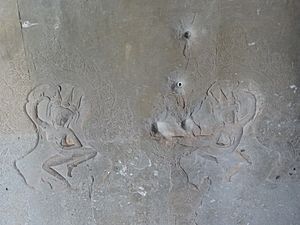
Restoration work stopped during the Cambodian Civil War and the Khmer Rouge rule in the 1970s and 1980s. But the temple was not badly damaged during this time. Khmer Rouge soldiers used some wood from the buildings for fires. A fight between Khmer Rouge and Vietnamese forces left a few bullet holes in a bas-relief. Much more damage happened after the wars. Art thieves from Thailand stole many heads from statues in the late 1980s and early 1990s.
In December 2015, researchers from the University of Sydney found new things at Angkor Wat. They found buried towers that were built and then taken down during the temple's construction. They also found a large structure on the south side, whose purpose is unknown. Wooden defenses were also found. These discoveries suggest that the temple area, surrounded by its moat and wall, might not have been used only by priests. It seems that ordinary people might have lived there too. The team used special tools like LiDAR and ground-penetrating radar to map the area.
According to a myth, the god Indra ordered Angkor Wat to be built as a palace for his son. A Chinese traveler from the 1200s, Zhou Daguan, wrote that some people believed the temple was built in just one night by a divine architect.
Architecture of Angkor Wat
Temple Layout and Meaning
Angkor Wat is special because it combines two Khmer temple styles. It has the "temple mountain" design, which was common for state temples. It also has the later design of "concentric galleries." Most of these designs came from Hindu religious beliefs. The way Angkor Wat is built also suggests it has a special meaning related to the sky. For example, it faces east-west. Also, from certain terraces, you can see specific towers line up exactly with the sunrise on a solstice (the longest or shortest day of the year).
The temple represents Mount Meru, the home of the gods in Hindu mythology. The five towers in the center stand for the five peaks of the mountain. The walls and moat around the temple represent the mountain ranges and the ocean. As you go higher into the temple, fewer people were allowed to enter. Only priests and the king could go to the highest levels.
The main tower of Angkor Wat lines up with the morning sun during the spring equinox. Unlike most Khmer temples, Angkor Wat faces west instead of east. Many experts, like Maurice Glaize and George Coedès, think this means King Suryavarman II wanted it to be his funeral temple. More proof for this idea comes from the bas-reliefs. They are carved in a counter-clockwise direction, which is the opposite of the usual order. This reverse order is used in Hindu funeral ceremonies.
Archaeologist Charles Higham also found a container in the central tower that might have been a funeral jar. Some say building this temple was the biggest effort ever made to honor a dead body. However, other experts point out that some other temples in Angkor also don't face east. They suggest Angkor Wat faces west because it was dedicated to Vishnu, who is linked with the west.
Building Style
Angkor Wat is a perfect example of the classical Khmer architecture style, which is now called the Angkor Wat style. By the 12th century, Khmer builders were very good at using sandstone as their main building material. They used sandstone blocks for most parts you can see. They used laterite (a type of soil that hardens) for the outer wall and hidden parts. We still don't know exactly what they used to stick the blocks together. Some think it was natural resin or slaked lime.
People praise the temple for its beautiful and balanced design. Maurice Glaize, who worked to preserve Angkor in the mid-1900s, said the temple "reaches a classic perfection." He noted its "finely balanced elements and the precise arrangement of its proportions."
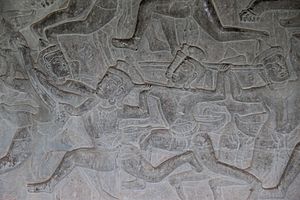
The special features of this style include:
- Towers shaped like lotus buds.
- Half-galleries to make walkways wider.
- Galleries that connect different parts of the temple.
- Cross-shaped terraces along the main path.
Typical decorations include devatas (or apsaras), bas-reliefs, and long garlands and story scenes on the pediments (triangular parts above doors). The statues at Angkor Wat are seen as more still and less graceful than older works. Other parts of the design have been lost over time or stolen. This includes gilded stucco on the towers and wooden ceilings.
Key Features
Outer Area
The outer wall is 1,024 meters (3,360 feet) long by 802 meters (2,631 feet) wide and 4.5 meters (15 feet) high. It is surrounded by a 30-meter (98-foot) wide open area and a moat that is 190 meters (620 feet) wide. The moat is over 5 kilometers (3 miles) around. You can enter the temple by an earth path on the east or a sandstone walkway on the west. The western walkway is the main entrance and was added later.
There are special entrance buildings called gopuras at each of the main directions (north, south, east, west). The western gopura is the largest and has three ruined towers. Under the southern tower is a statue called Ta Reach. It was originally an eight-armed statue of Vishnu. Galleries connect the towers and lead to two more entrances, sometimes called "elephant gates" because they are big enough for elephants.
The outer wall surrounds an area of 820,000 square meters (203 acres). This area once held the city and the royal palace, north of the temple. These buildings were made of wood, so nothing remains of them today except the outlines of some streets. Most of this area is now covered by forest. A 350-meter (1,150-foot) long walkway connects the western gopura to the main temple. It has naga (snake) railings and six sets of steps. Each side also has a library building and a pond between the library and the temple. The ponds were added later.
Central Area
The temple sits on a terrace that is higher than the city. It has three rectangular galleries, each one rising higher than the last, leading to a central tower. The two inner galleries each have four large towers at their corners. These surround a fifth, even higher tower in the middle. This five-tower pattern is called a quincunx. It represents the mountains of Mount Meru. Since the temple faces west, the features are set back towards the east. This leaves more space on the west side of each area. The west-facing steps are also less steep.
Each gallery has a gopura (entrance building) at each main direction. The outer gallery is 187 meters (614 feet) by 215 meters (705 feet). It has open pavilions instead of towers at its corners. A cross-shaped cloister (a covered walkway) called Preah Poan connects the outer gallery to the second area on the west side. This cloister means "The Thousand Buddhas Gallery." Over the centuries, pilgrims left many Buddha images here, though most have been removed. This area has many writings from pilgrims, mostly in Khmer, but also in Burmese and Japanese. The four small courtyards inside the cloister might have once been filled with water.
Beyond this, the second and inner galleries are connected by another cross-shaped terrace, which was also added later. From the second level up, many devatas (female figures) decorate the walls. The second-level area is 100 meters (328 feet) by 115 meters (377 feet). It might have been filled with water to represent the ocean around Mount Meru. Three sets of very steep steps on each side lead up to the inner gallery. These steep stairs represent how hard it is to reach the gods' kingdom. This inner gallery, called the Bakan, is a 60-meter (197-foot) square. It has galleries connecting each gopura to the central shrine. Smaller shrines are located under the corner towers.
The roofs of the galleries are decorated with carvings of snake bodies ending in lion or garuda (mythical bird) heads. Carved lintels and pediments decorate the entrances. The tower above the central shrine rises 43 meters (141 feet) high, reaching 65 meters (213 feet) above the ground. Unlike earlier temple mountains, this central tower is higher than the four surrounding ones. The shrine itself originally held a statue of Vishnu and was open on all sides. But it was walled in when the temple became Theravada Buddhism|Buddhist. The new walls have standing Buddhas.
Decorations
Angkor Wat is famous for its many beautiful decorations, mostly in the form of bas-relief carvings. The inner walls of the outer gallery have large scenes. They mostly show stories from the Hindu epics, the Ramayana and the Mahabharata. One expert called these "the greatest known linear arrangement of stone carving."
- The western gallery shows the Battle of Lanka (from the Ramayana, where Rama defeats Ravana). It also shows the Battle of Kurukshetra (from the Mahabharata, showing two families fighting).
- The southern gallery shows a historical scene: a procession of Suryavarman II. Then it shows the 32 hells and 37 heavens of Hinduism.
- The eastern gallery has one of the most famous scenes: the Churning of the Sea of Milk. This shows gods and demons using a giant snake to churn the sea under Vishnu's guidance. It is followed by Vishnu defeating demons.
- The northern gallery shows Krishna's victory over Bana.
Angkor Wat is also decorated with many apsaras and devata figures. There are over 1,796 of these figures. Angkor Wat architects used small apsara images (30-40 cm or 12-16 inches tall) as decorations on pillars and walls. They put larger devata images (95-110 cm or 37-43 inches tall) more clearly at every level of the temple. In 1927, Sappho Marchal studied these figures. She found a huge variety in their hair, headdresses, clothes, poses, jewelry, and flowers. She believed these were based on real styles from the Angkor period.
How it was Built
The monument was built using five to ten million sandstone blocks. Each block weighed up to 1.5 tons. The entire city of Angkor used much more stone than all the Egyptian pyramids combined. It also covered a much larger area than modern-day Paris. Unlike the Egyptian pyramids, which used limestone from nearby, Angkor was built with sandstone from 40 kilometers (25 miles) or more away. This sandstone came from Mount Kulen.
It was thought that the stone was transported 35 kilometers (22 miles) along a canal to Tonlé Sap lake. Then it crossed the lake for another 35 kilometers (22 miles). Finally, it went 15 kilometers (9 miles) up the Siem Reap River. This would make a total journey of 90 kilometers (56 miles). However, in 2011, researchers found a shorter 35-kilometer (22-mile) canal connecting Mount Kulen and Angkor Wat using satellite images. They believe the Khmer people used this shorter route.
Almost all surfaces, columns, and even roofs are carved. There are kilometers of carvings showing scenes from Indian literature. These include unicorns, griffins, winged dragons pulling chariots, and warriors. The gallery walls alone have almost 1,000 square meters (11,000 sq ft) of bas-reliefs. Holes on some walls suggest they might have been decorated with bronze sheets. These were very valuable and often stolen.
Experts have tried to recreate stone carvings. A sculptor took about 60 days to carve a stone sculpture under 4 feet (1.2 meters). Another experiment showed that 12 quarrymen took 22 days to quarry about 400 tons of stone. This means thousands of workers and many skilled artists must have been needed to quarry, transport, carve, and install all the sandstone. The skills to carve these sculptures were developed hundreds of years before the Khmer Empire became powerful.
Angkor Wat Today
Restoration and Care
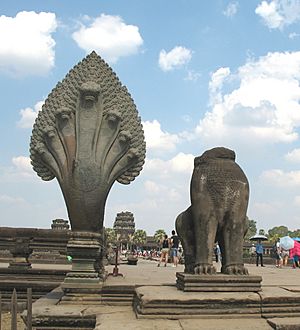
Like most old temples in Cambodia, Angkor Wat has been damaged over time. This damage comes from plants growing on it, fungi, ground movements, war, and theft. However, the war damage to Angkor Wat was very small compared to other temple ruins in Cambodia. It has also received the most careful restoration.
Modern restoration of Angkor Wat began in 1908. Before that, people were mostly exploring the site. Work on Angkor stopped during the Khmer Rouge era (1970s). Between 1986 and 1992, India helped restore the temple. Some people have criticized early French and later Indian restoration efforts. They worry about damage to the stone from chemicals and cement.
In 1992, Angkor Wat was listed as a World Heritage Site by UNESCO. It was also put on the "World Heritage in Danger" list (removed in 2004). This was to ask for international help to save Angkor. Rules were set up in 1994 to protect the site. A group called APSARA was created in 1995 to manage the area. A law to protect Cambodian heritage was passed in 1996.
Many countries like France, Japan, and China are now helping to preserve Angkor Wat. The German Apsara Conservation Project (GACP) works to protect the devatas and other carvings from damage. Their study found that about 20% of the devatas were in very bad condition. This was mainly due to natural wear and tear, but also partly from earlier restoration work. Other projects involve fixing fallen parts of the temple and preventing more collapses. For example, the west side of the upper level has had scaffolding since 2002. A Japanese team finished restoring the north library in 2005.
Tiny living things called microbial biofilms have been found damaging the sandstone at Angkor Wat. These can produce acids that break down the stone. Replicas have been made to replace some lost or damaged sculptures.
Tourism at Angkor Wat
Since the 1990s, Angkor Wat has become a very popular place for tourists. In 1993, only 7,650 people visited. By 2004, over 561,000 foreign visitors came to Siem Reap province, where Angkor Wat is. This was about half of all foreign tourists in Cambodia. The number grew to over a million in 2007, and over two million by 2012. In 2018, 2.6 million foreign tourists visited Angkor Wat.
A private company managed the site from 1990 to 2016. The large number of tourists has caused little damage so far, mostly just some graffiti. Ropes and wooden steps have been put in place to protect the carvings and floors. Tourism also provides some money for upkeep. About 28% of ticket money from the whole Angkor site goes to the temples. However, most of the big restoration work is paid for by foreign governments.
Because tourism has grown so much, UNESCO and other groups have held meetings. They want to make sure tourism helps Cambodia's economy but also protects its culture. They want to avoid too much commercial development. There have been concerns that new large hotels and roads could harm the landscape and the local water, sewage, and electricity systems. The high number of tourists and demand for hotels might also affect the underground water, which could harm the temples' structure.
Local people in Siem Reap are also worried that their town's charm is being lost because of tourism. Local officials are discussing how to manage future tourism without losing local values and culture.
In 2012, it was agreed that Angkor Wat and Borobudur (another famous temple) would become "sister sites." This means they would work together.
In 2020, the COVID-19 pandemic caused travel rules that greatly affected tourism in Cambodia. Visitors to Angkor Wat dropped sharply, leaving the usually busy complex almost empty.
See Also
 In Spanish: Angkor Wat para niños
In Spanish: Angkor Wat para niños
- Cambodia
- Indosphere
- Greater India
- Buddhism in Cambodia
- Buddhism in Southeast Asia
- List of Hindu temples
- List of Buddhist temples
Images for kids


